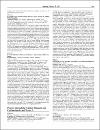Defective Interaction of Cam with RyR2 Cam-Binding Pocket Might Contribute to Arrhythmogenic Cardiac Disease

Date
2020-02Author
Nomikos, MichailThanassoulas, Angelos
Vassilakopoulou, Vyronia
L. Calver, Brian
Livaniou, Evangelia
Safieh-Garabedian, Bared
Toft, Egon
Nounesis, George
Lai, F. Anthony
...show more authors ...show less authors
Metadata
Show full item recordAbstract
Ryanodine receptor 2 (RyR2) is a large transmembrane calcium (Ca2+) release channel that mediates Ca2 release from the sarcoplasmic reticulum to activate cardiac muscle contraction. Calmodulin (CaM) regulation of RyR2 is essential for normal cardiac function. A number of linear fragments of RyR2 have been reported as potential CaM-binding sequences. The sequence 3583-3603aa of human RyR2, which is highly conserved among mammalian isoforms, has been identified as a CaM-binding site in almost all relevant studies and therefore this region is considered as a well-established CaM-binding domain of RyRs. Besides 3583-3603aa region, other RyR2 regions have been also reported as potential CaM-binding sequences. Herein, we used recombinant wild-type CaMprotein and isothermal titration calorimetry (ITC) experiments to screen a number of RyR2-specific synthetic peptides corresponding to the region 4240-4277aa of RyR2, which has been previously proposed as a putative CaM-binding RyR2 region. From all the synthetic peptides screened, a peptide corresponding to 4255-4271aa region of human RyR2 was found to interact with significant affinity with RyR2, in the presence and absence of Ca2+ (Kd values 0.60 and 16.58 μM, respectively). Moreover, investigation of the interaction of four arrhythmogenic CaM mutants (N98I, D132E, D134H and Q136P) with this synthetic peptide, as well as the peptide corresponding to the well-established CaM-binding domain of RyR2 (3583-3603aa), revealed that all mutants show disparate binding properties to these two RyR2 peptides, which have been previously proposed to contribute to a putative intra-subunit CaM-binding pocket. Our findings extend our previous observations suggesting that CaM mutations may trigger arrhythmogenic cardiac disease by altering both intrinsic Ca2+-binding, as well as by dysregulating RyR2-mediated Ca2+ release via defective interaction of CaM with a distinct CaM-binding pocket that multiple RyR2 regions might contribute.
Collections
- Medicine Research [1912 items ]


